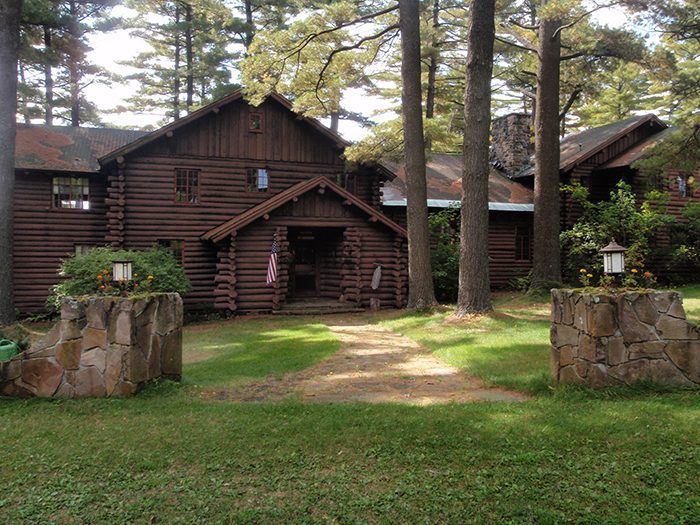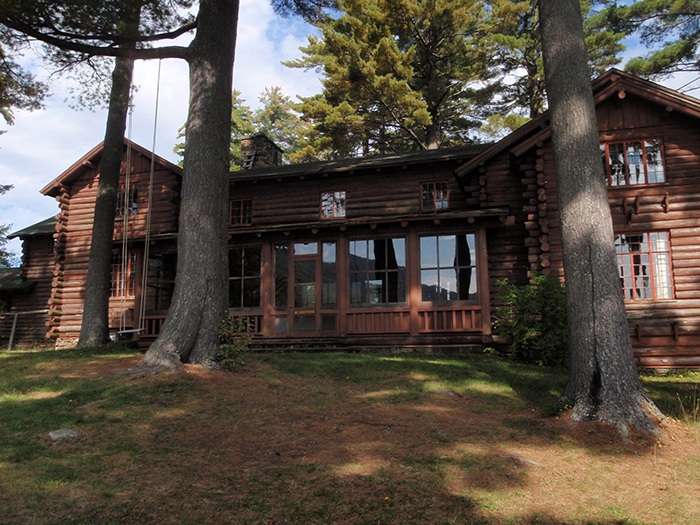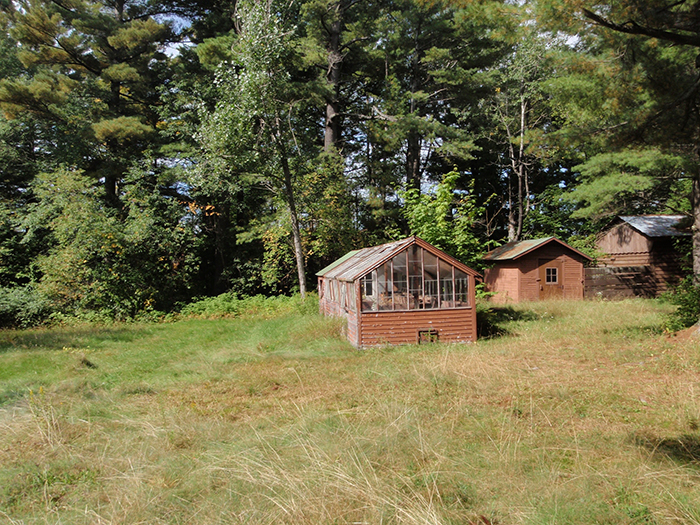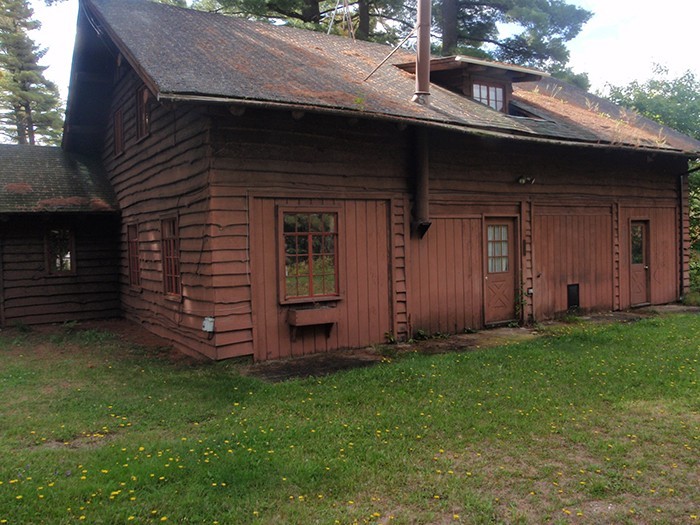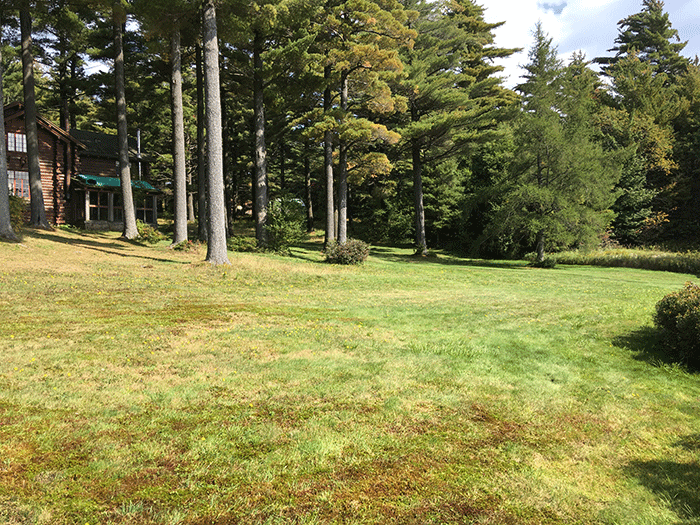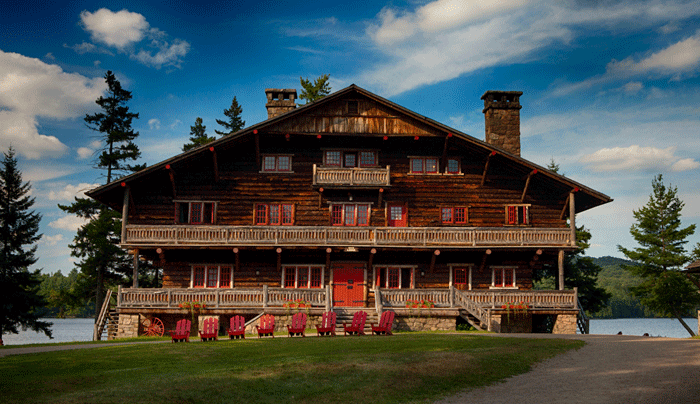The State of New York Proposes a new 41-acre “Day Use Area” at Debar Lodge and Debar Pond, while supporters of keeping the dilapidated complex of buildings seek an Article 14 amendment for 6 acres to create a privately owned institute.
Protect the Adirondacks says to remove the buildings and restore the site to a wild forest setting.
There’s an active debate about the future of the dilapidated Debar Lodge, which is on the Debar Mountain Wild Forest Area, in the northern Adirondacks in the Town of Duane in Franklin County. The state wants to tear down the dozen buildings and create a new public day use area with large pavilion, public restrooms, maintenance building and staff on-site. The state has proposed a 41-acre reclassification of Wild Forest Lands to Intensive Use to facilitate this new facility. A private effort wants to amend the State Constitution to obtain all the buildings and six acres of land, removing them from the Forest Preserve, to create a private institute. Protect the Adirondack rejects both of these ideas. Protect the Adirondacks wants to see all of the buildings removed and the site reclaimed and reforested so that Debar Pond is managed as a wild, motorless lake.
As part of the new draft Debar Mountain Complex Unit Management Plan (DMCUMP), which includes the 80,400-acre Debar Mountain Wild Forest Area, the Department of Environmental Conservation (DEC) seeks to reclassify 41 acres of Wild Forest to create a new Debar Pond Intensive Use area. The DEC and Adirondack Park Agency (APA) jointly released a draft Debar Lodge Day Use Area Unit Management Plan (DLDUAUMP) that outlined the state’s plans. This new Intensive Use area would be managed as a day use area, which the state says will be “a hub for recreation access to adjacent lands, a connection to the history of the site, and a recreation destination for the community.”
Protect the Adirondacks does not support an amendment to Article 14, Section 1 to authorize the removal of the Debar Lodge complex from the Forest Preserve so it can be managed as a 6-acre private inholding as some type of commercial and educational facility. We believe that the best long-term use of the Debar Lodge/Debar Pond site is removal of the buildings and restoration of the site to a wild forest setting. Protect the Adirondacks opposes the preferred Intensive Use Area classification and urges the APA and DEC to keep these lands as Wild Forest in order to provide the highest environmental protection possible for Debar Pond and allow the ecological recovery and restoration of the Debar Lodge area. Click here for our public comments on the recent public hearing.
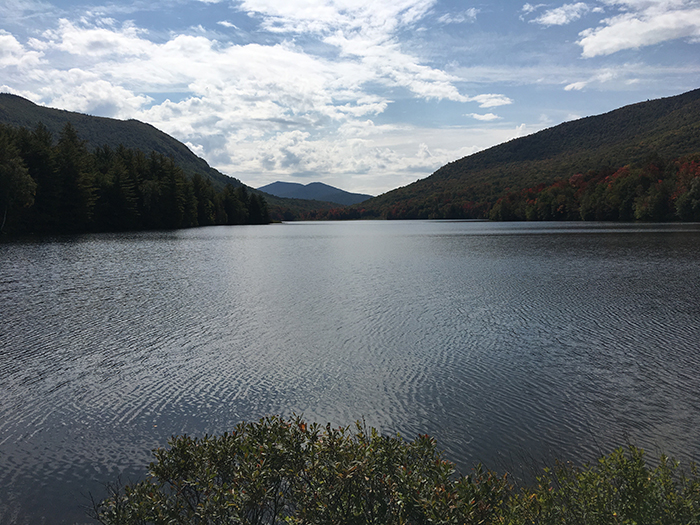
Debar Pond is a 90-acre lakes surrounded by forests and mountains. The Debar Lodge complex sits at the north end of the pond.
Public use at Debar Pond has tripled in the past several years. The DEC says that this is because Debar Lodge was no longer used as a private residence by a DEC staffer/caretaker, making the site more open and welcoming to the public. Perhaps this is so, but more likely it is the fact that word got out about great flatwater canoeing on Debar Pond once it was more fully open to the public. We believe that the best option for Debar Lodge/Debar Pond is to remove all buildings and restore the site to a wild forest area and for Debar Pond to be managed as a wild, motorless lake, akin to Round Lake or Lake Lila.
Protect the Adirondacks is also concerned about the process chosen by the APA and DEC for reclassification. We’re unfamiliar with other times that the DEC has released a draft UMP for an area as part of a state lands reclassification or classification process. This is highly unusual. Moreover, the draft DLDUAUMP contains proposed architectural designs and site plans that the DEC must have purchased from an outside contractor. Either the decision to spend state monies on building designs before a classification that would allow them is finalized is unwise, or, even more troubling, the decision has already been made for all practical purposes. The process here is unusual and not one that we’re confident will produce a good public and environmental outcome.
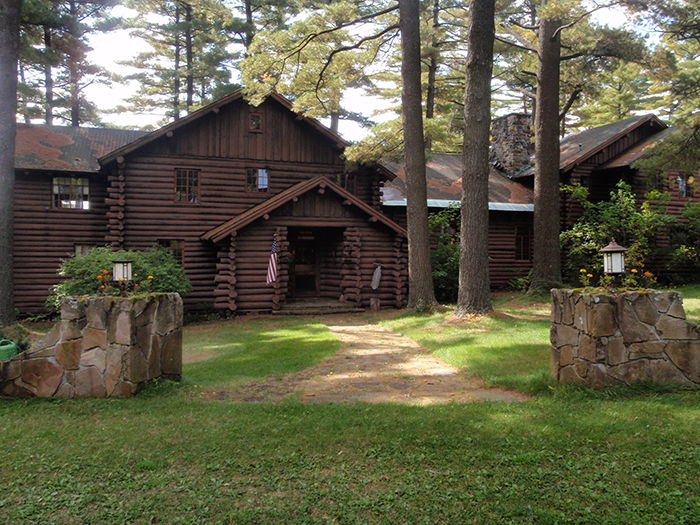
The main building of the Debar Lodge complex. These buildings were purchased in the 1980s along with thousands of acres of forests around Debar Pond. Private owners retained use until 2005. The main lodge (above) is a complex of more than a dozen buildings, most in disrepair. The NYSDEC now says it wants to remove all the buildings and create a new Day Use Area, while a private group wants to remove six acres and all the buildings from the Forest Preserve to create a campus for a private institute. Protect the Adirondacks is pressing for all buildings to be removed and the site restored to a wild forest setting.
Protect the Adirondacks has many concerns about the public process underway to make changes to the Debar Mountain Wild Forest area. We find no real discussion in the state’s hearing documents about the need for a new Intensive Use area in this part of the Adirondack Park. Nearby, of course, are the Meacham Lake and Buck Pond Intensive Use areas, which also function as day use areas and overnight camping areas. A bit farther away are the extraordinary Rollins Pond and Fish Creek Intensive Use/Day Use areas. The DLDUAUMP states that facilities are close to Debar Pond and are rarely filled to capacity.
The DLDUAUMP fails to state why a new Intensive Use area at the Debar Lodge site is needed. At a time of extremely limited resources for Forest Preserve management, when the High Peaks Wilderness area is suffering from an explosion of public use and chronic under investment in trails and facilities, it makes little sense to construct a new, redundant day use area at Debar Pond that long after it is built will require significant annual resources to maintain it year after year. The new Intensive Use area is inappropriate for this site because it would be redundant with other Intensive Use facilities nearby. The expense of building, and then staffing, a new Intensive Use area at Debar Pond is a poor long-term investment for the Adirondacks, saddling future administrations with a white elephant to fund in perpetuity.
After examining the different alternatives in the DLDUAUMP, we believe that the buildings from the Debar Lodge complex should be removed. Many of the buildings in this complex are in disrepair. We do not believe that Debar Lodge is a Great Camp worth saving.
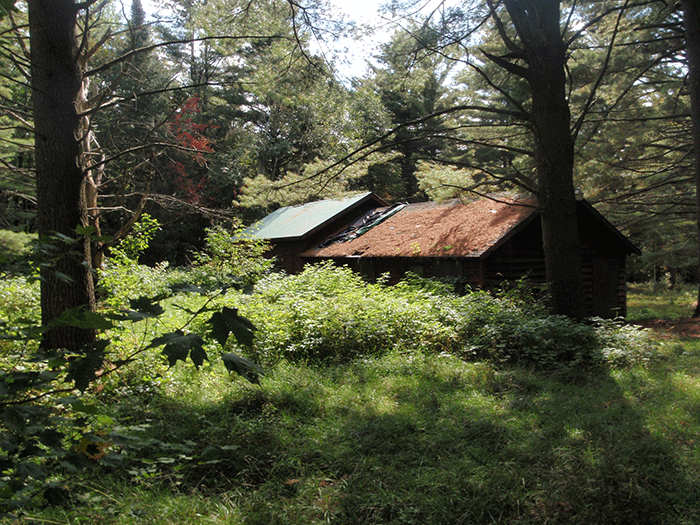
The pictures above show the current state of the buildings in the Debar Lodge complex, where many are in disrepair. Protect the Adirondacks believes that these buildings should be removed and the site should restored to a wild forest setting.
Create a Lake Lila-Style Wild, Motorless Lake Canoeing and Camping Experience at DeBar Pond: The greatest value of the Debar Lodge/Debar Pond site is Debar Pond. The DEC has an opportunity to create a new Lake Lila-style wild area. The Debar Lodge building complex should be removed and the site allowed to reforest. Active restoration and tree planting would help to speed the process. The site should remain in Wild Forest and the parking lot and access road kept where they are, if not eventually moved out to the main road. In the Adirondack Park there is not a demand or need for more Intensive Use areas. The under-utilization of the facilities nearby shows this clearly, but there is a need for more wild motorless lake experiences easily accessible for people with a modest canoe carry. We have such an opportunity at Debar Pond.
In our vision, Debar Pond would be a place that can grow even wilder in the future than it is today. In our vision, Debar Pond would be another Lake Lila or Boreas Pond or Little Tupper Lake or Henderson Lake, a motorfree and wild lake where the public can canoe, hike, and camp in a wild landscape that will remain undisturbed for generations. A place where grandparents can one day bring their grandchildren to experience wildness in much the same way, unchanged and beautiful, as they experienced at Debar pond as children. That is the promise of the Forest Preserve.
Many Great Camps, recognized for their architectural and social history, are protected and have been restored by private owners across the Adirondack Park. Most of these camps today are located on relatively small acreages, with a few exceptions, where it is unlikely that they would be part of any future public purchases for the Forest Preserve. The future of these several dozen Great Camps is reasonably secure as these camps are privately owned and maintained.
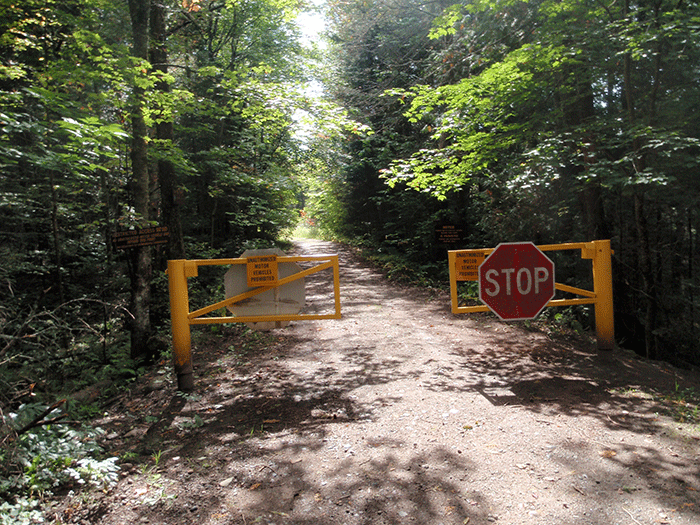
This picture shows the gates on the Debar Pond Road. PROTECT believes that the road should be closed at this point and visitors should walk and carry their canoes to the quarter mile to Debar Pond.
Cautionary Tales of Three Great Camps and the Forest Preserve: Protect the Adirondacks is well aware of the tortured history of buildings on the public Forest Preserve. Over the last 50 years, three Great Camp sagas provide cautionary tales for the management of Great Camps and the Forest Preserve. First, there was Great Camp Nehasane on Lake Lila. The State of New York purchased Lake Lila and several thousand acres around it in the 1970s. Nehasane Lodge was located at the west end of Lake Lila. Peter Berle, then DEC Commissioner, oversaw the demolition and removal of that Great Camp. Today, Lake Lila is a treasured part of the William C. Whitney Wilderness area and has been enjoyed by hundreds of thousands of people through the decades for its beauty and wildness. Had Nehasane Lodge remained, the entire Lake Lila experience today would be fundamentally different and significantly diminished. Protect the Adirondacks believes that Lake Lila’s restoration and its classification as Wilderness is one of the great success stories in the Adirondack Park. Today, Lake Lila provides a stunningly beautiful Wilderness landscape and experience. The lake is heavily used by the public all summer long, year after year. We believe that the Berle vision for Lake Lila was prescient and was the right decision because wild, motorfree lakes have only grown rarer and more precious in the last 50 years.
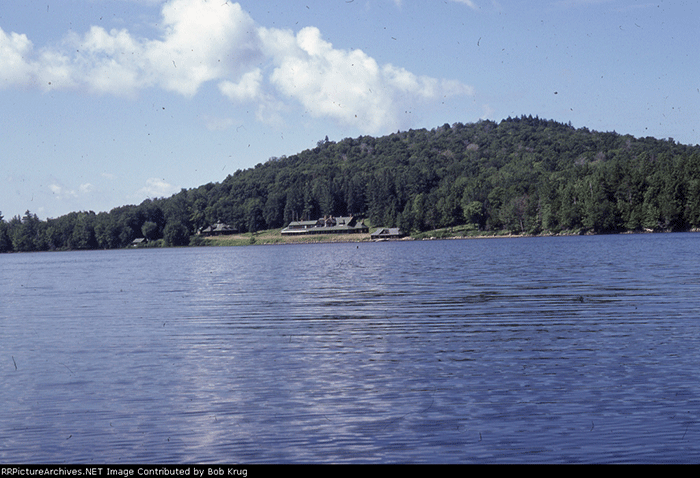
Nehasane Lodge at Lake Lila in the early 1970s. This complex of buildings was removed in the late 1970s by then NYSDEC Commissioner Peter A.A. Berle.
The second cautionary tale is Great Camp Santanoni on Newcomb Lake, an inholding of sorts within the High Peaks Wilderness. This Great Camp was purchased in the 1970s as part of a 12,000-acre purchase of lands that were added to the High Peaks Wilderness. Great Camp Santanoni existed in a state of benign neglect for decades. State laws were passed to allow buildings to remain on the Forest Preserve if they met a specific purpose. Great Camp Santanoni was eventually stabilized with state funding. The Great Camp Santanoni complex, and its access road, remained in the Forest Preserve and were classified as a Historic Area under the Adirondack Park State Land Master Plan. The first iterations of the APSLMP in the 1970s did not have a Historic classification, but it was added in subsequent revisions. The State of New York has spent millions of dollars to stabilize and restore Great Camp Santanoni.
In our vision, the continued existence of Great Camp Santanoni, which we acknowledge is an attraction for many people and is considered as an important cultural resource in the Town of Newcomb, has diminished the public experience on Newcomb Lake. The Historic Area has also created management tensions from using snowmobiles to ferry staff and supplies to the Great Camp on the 5-mile-long access road in the winter and state administrative use of that road with motor vehicles in summer months. Despite these problems, we foresee the continuation of Great Camp Santanoni and recognize that it provides a viable public education and interpretation experience for Adirondack Great Camp architectural and social history. There is no need for another Great Camp in the Forest Preserve.
The third cautionary tale is of Great Camp Sagamore outside of Raquette Lake. Great Camp Sagamore is a fully restored Great Camp complex that sits on the shore of Sagamore Lake. Two Article 14 amendments in the 1980s transferred Great Camp Sagamore and more than a dozen acres to a private institute for educational purposes. The Sagamore Institute has worked since the 1980s to provide public education and interpretation about Adirondack Great Camp architectural and social history. The facility is also used for private conferences and events such as weddings. Public access to Sagamore Lake is sharply curtailed. Public parking areas and access to the lake have never been adequately developed. The guests at the Great Camp enjoy easy lake access from a restored boathouse and series of docks, which are off limits to the public. The Great Camp Sagamore complex dominates the lake where members or the public are in essence second class citizens. Today, Great Camp Sagamore provides the most indepth educational opportunity for Great Camp architectural and social history in the Adirondack Park for paying customers. While the Great Camp complex is fully restored, the public experience on Sagamore Lake has always been circumscribed by the Great Camp. Sagamore Lake is no Lake Lila, though had the Great Camp been removed over 40 years ago, it would be a Lake Lila today.
Last, if Debar Lodge is classified as Historic, this will necessitate millions of dollars in state funds for the stabilization and restoration of the buildings, similar to what has happened with Camp Santanoni.
Protect the Adirondacks recognizes the necessity of compromise in the management of the Adirondack Park. We recognize that the Adirondack Park of today is forged from a series of decisions and compromises made decades ago. However, we do not believe that the Camp Santanoni model is appropriate for Debar Lodge. We do not believe that the Camp Sagamore model is appropriate for Debar Lodge. We believe that the Great Camp Nehasane model is the most appropriate for Debar Lodge. We believe that the Debar Lodge complex should be removed and the site restored to a Wild Forest setting. In this way, we’re confident that Debar Pond will grow wilder and even more beautiful in future decades. We believe that there is no greater gift to future generations than wild spaces around a wild and motorfree Debar Pond.
It’s important to note that most of the major lakes in the Adirondacks are open to all manner of motorized watercraft. A report published by Protect the Adirondacks in 2013 The Myth of Quiet, Motor-free Waters in the Adirondack Park found that of the 100 largest lakes in the Adirondacks, from Lake Champlain to Beaver Lake (in Watson and Webb in western Adirondacks), 77 are open for all manner of motorized boating and floatplanes, 14 lakes are privately owned and provide no public access, and just 8 are motor-free. Of the eight motor-free lakes among the Park’s top 100, just five are relatively easy to access for families and motor-free. Just 17 of the biggest 200 lakes are easily accessible and motor-free. The demand is high for motor-free experiences, but the supply is low. This needs to change. The public deserves more opportunities for motorfree waters across the Adirondack Park and Debar Pond creates that opportunity to accomplish this.
A motor-free Debar Pond, where the Debar Lodge site has been restored and reclaimed, will grow into a popular lake for campers, hikers and paddlers, who will cherish this wild place for generations.
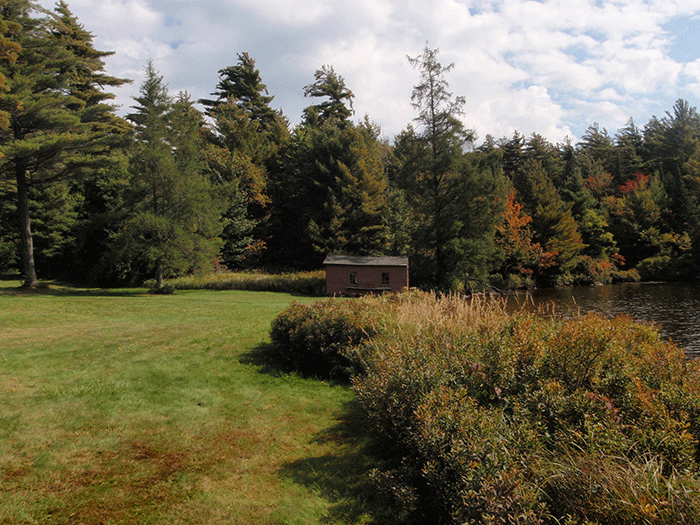
The shoreline of Debar Pond near Debar Lodge. This area should not be privatized for the benefit of the paying guests of a private landowner. Protect the Adirondacks opposes an Article 14 amendment for the Debar Lodge site.
Cost Benefit Analysis: This decision cries out for a serious cost-benefit analysis. The state has not undertaken any type of a cost-benefit analysis in any serious way.
Adirondack Park State Land Master Plan: The Adirondack Park State Land Master Plan (APSLMP) states:
If there is a unifying theme to the master plan, it is that the protection and preservation of the natural resources of the state lands within the Park must be paramount. Human use and enjoyment of those lands should be permitted and encouraged, so long as the resources in their physical and biological context as well as their social or psychological aspects are not degraded. This theme is drawn not only from the Adirondack Park Agency Act (Article 27 of the Executive Law “The Act”) and its legislative history, but also from a century of the public’s demonstrated attitude toward the forest preserve and the Adirondack Park.
Our review of the various proposals find that state agencies have not upheld the “unifying theme” for natural resource protection in the APSLMP.
Protect the Adirondacks will continue to make the case that Debar Lodge and all other buildings should be removed and the site should be restored and managed as a wild, motorless area.

